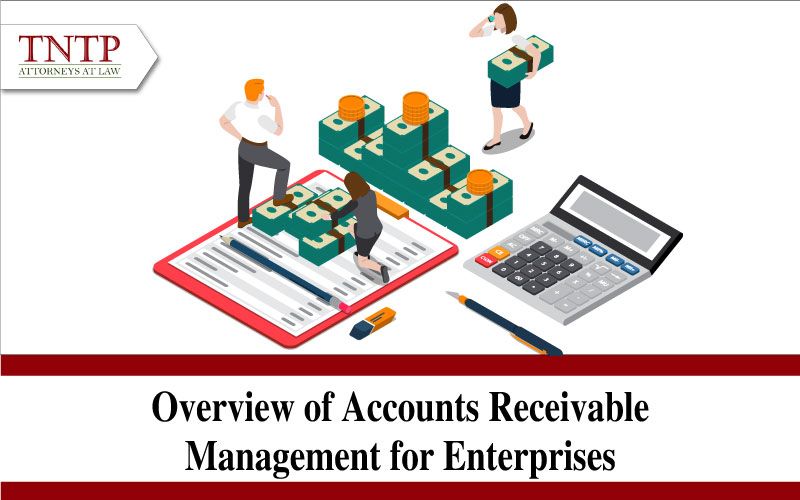Overview of accounts Receivable Management for Enterprises

The business operations of enterprises and organizations require a rigorous and clear management system to achieve their goals effectively. Among them, accounts receivable management is one of the crucial factors, contributing to maintaining financial stability and optimizing cash flow. In this article, TNTP will provide an overview of “Accounts Receivable Management for Enterprises”.
1.Definition of Accounts Receivable Management for Enterprises
Enterprise debt management is the process of controlling, monitoring, and handling receivables and payables in business activities to maintain stable cash flow, reduce financial risks, and support sustainable growth. Specifically, accounts receivable management involves establishing policies, tracking payment status, pursuing debt collection, and addressing bad debts when necessary. When implemented effectively, this system will help enterprises optimize capital resources, improve debt recovery rates, and minimize the risk of losing funds.
2.Enterprises Need to Establish a Rigorous Accounts Receivable Management Regulation
To effectively manage accounts receivable and conduct debt recovery, enterprises should consider creating management regulations that include these key elements:
a.The enterprise’s accounts receivable management system must have specific regulations for debt classification
The regulation helps categorize debts according to the value, ageing period, debtor cooperation level, and financial capability, thereby determining the priority level for recovery and appropriate handling solutions.
Specifically, all debts and debtors must be classified into specific groups to implement corresponding debt recovery measures. For instance, recently incurred small-value debts are assigned a lower collection priority compared to high-value debts that have remained outstanding for an extended period, and the corresponding recovery measures for these two categories will also be distinct.
The management and categorizing of debts will help enterprises create efficient debt recovery plans for each corresponding debt. This crucial first step should be taken whenever debt arises, ensuring proper monitoring and timely handling them effectively while preventing overlooked debts from disrupting the company’s cash flow.
b.The enterprise’s accounts receivable management system must have specific regulations for debt collection procedures
Enterprises should establish a standardized debt management system with clear procedures for debt collection from basic communication through phone, email, and written documents to advanced measures like filing lawsuits. Using standard procedures enables enterprises to track, manage, and evaluate debt collection progress effectively. This allows enterprises to adjust their debt resolution strategies for each case, ensuring quick, effective, and cost-efficient recovery.
3.Accounts Receivable Management Process in Enterprises
Accounts receivable management and debt recovery are essential factors related to corporate finance. Based on the above contents, TNTP outlines a process for enterprises to manage accounts receivable in compliance with legal regulations as follows:
Step 1: Develop an Accounts Receivable Management Regulation
Develop a management regulation that includes:
- Categorizing debts and debtors
- Debt resolution procedures
- Responsibilities of relevant departments and individuals
- Measures for handling bad debts
Step 2: Record Debts and Issue Invoices
- Issue official invoices according to contractual agreements and legal requirements
- Record debts in the accounting system
- Send invoices and confirm debts with customers
Step 3: Categorize Debtors
Classify customers according to payment risk levels: Group of customers nearing payment due date, group of customers with late payments, group of customers with bad debts.
Step 4: Monitor and Remind Payments Before Due Dates
- Send payment reminders to customers approaching payment deadlines
- Update the payment status of customers
- Contact customers if there are signs of late payment
Step 5: Recover Overdue Debts
- Request debtors to sign the Debt reconciliation records
- Contact customers via email, phone, and official letters to request payment
- Arrange meetings with debtors to find payment solutions
- Negotiate with debtors on payment schedules
- If debtors continue to delay payment, enterprises may consider engaging law firms to handle debt recovery through litigation or appropriate legal measures.
Step 6: Store Documents and Monitor the Payment Process
- Fully store transaction documents, invoices, and Debt reconciliation records
- Regularly update payment status
- Review and optimize the accounts receivable management process
Effective accounts receivable management not only helps enterprises maintain stable cash flow but also reduces financial risks, ensuring sustainable business operations. TNTP hopes this article provides useful information, offering you an overview of “Accounts Receivable Management for Enterprises”.
Best regards,



